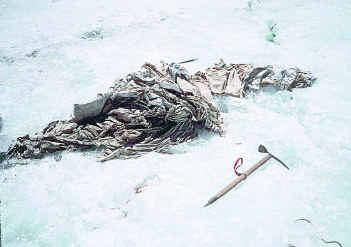George Mallory was the mountain climber who, when asked why he wanted to climb Mount Everest, replied, “Because it is there.” This has generally been taken to mean– “because it exists, because it is a challenge, because it has been put before us as something we must conquer!” In fact, he may have simply been expressing his exasperation at hearing the same question over and over again. “Because it’s there… Stupid.”
Mallory was lost somewhere high on the North side of Everest on June 8, 1924. A few weeks ago, his body was found by an expedition filming a tv special for PBS’s NOVA. It is remarkably well-preserved. The exposed skin is ivory white, smooth, and hard. He appears to have fallen: one leg is broken, and there is a shoulder injury, and he is facing down, his arms spread out as if he was trying to stop himself from sliding down the mountain. It looks like he fell, injured himself, and then just lay there for some time, waiting for the inevitable end. It was a sad, lonely way to die.
There was no sign of Irvine. Another intriguing mystery: did his climbing partner Sandy Irvine, see the fall? Did they both fall (they were likely tethered) and end up in different locations? Did Irvine survive the fall and set off on his own to descend only to become lost?
Mallory, as noted, was lost on the North side. Most expeditions to Everest nowadays (and the first successful expedition in 1953) follow a route up the South side, considered more accessible, but back in 1924, foreigners were generally not permitted into Nepal.
The location of the body raises the intriguing question of whether Mallory and his partner Andrew Irvine may have summitted before disaster struck on the way down. Nobody knows. The last person to see them alive, Noel Odell, reported that they were within a few hours of the summit at about 1:00 p.m. When his body was found, his sun-goggles were stuffed into his shirt pocket. That suggests that it was past daylight at the time he fell. And the location of the body, well below where he was last seen, suggests that he was on his way down, not up, at the time of the accident.
There is a very difficult notch in the summit ridge just below the peak, an almost vertical climb of 80 feet or so. The problem with the theory that Mallory summitted is the question of how he got over that notch. In the early 1960’s, the Chinese finally got over the notch by pushing a man up through a crevice, but he had to use his bare hands to make it and suffered some frostbite. Once they got a man up there, they tied a ladder in place, and almost all climbers since have used the ladder. (How does that play with your perception of just how athletic mountain climbers are?) However, the team that found Mallory’s body is incorrect in saying that nobody else has ever climbed the North Ridge without the ladder: last year, another expedition, finding the ladder damaged, did manage to climb it, as did a member of the expedition sent to find Mallory’s body. So he could have done it.
If he had not been able to climb the step, then he would probably have turned around well before daylight expired, and thus would not have tucked his goggles away into his pocket before reaching the slope where his body was found. It’s an intriguing mystery. History may yet be rewritten.
On the other hand, as some, including his son, have pointed out, it’s getting back down alive that counts.
The answer may be contained in Mallory’s camera, if they can find it. Kodak says they can probably develop the film, even after 75 years.
Mallory’s body was left on Everest. That is a tradition among climbers that is the product of necessity: it is very difficult to recover bodies from the unforgiving mountain. He is among the first of 142 bodies currently residing on the majestic mountain.

2013-06-21
Let’s dust a bit of the blather about nobility and honor and class off this story, shall we? At least one excellent climber (Richard B. Graham) was excluded from the team because he was a Quaker and hadn’t participated in the slaughter of World War I. Another was excluded because he was Australian (George Ingle Finch) and, ho ho, pip pip, I say, we can’t have a bloody Australian on the summit along with an Englishman! It’s just not British!
Wikipedia describes how Mallory and Irvine, after failing to climb Everest or to return, were acclaimed as “national heroes”. That’s really quite fascinating. It certainly isn’t the result of a great achievement, because many other men ascended as far as they did without conquering the summit and none of them have been acknowledged as heroes. I think it is a rationalization. They died. Their lives must not have been wasted in a frivolous attempt at personal or national glory. Therefore, they are “heroes”. To say otherwise makes you disloyal and disrespectful.
